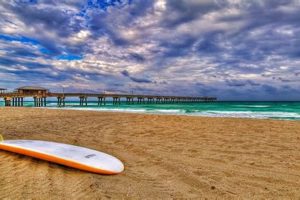Information detailing wave conditions, tide levels, water temperature, and wind forecasts for the coastal areas of Virginia Beach constitutes a crucial resource for water sports enthusiasts. This data enables individuals to assess the suitability of current ocean conditions for activities such as surfing, swimming, and fishing.
Accurate and timely insights into these environmental factors are paramount for safety and enjoyment. Historically, reliance on personal observation and anecdotal evidence has given way to sophisticated forecasting models and real-time monitoring systems, enhancing the precision and accessibility of this information. The availability of such data minimizes risks associated with unpredictable ocean dynamics and contributes significantly to informed decision-making regarding coastal recreational activities.
The subsequent analysis will delve into the specific components of these reports, the various sources from which they are derived, and the optimal methods for interpreting them effectively to plan a visit to the coast.
Maximizing safety and enjoyment of the coastal environment necessitates a strategic approach to understanding available resources. Proper interpretation of readily accessible information allows for informed decision-making, optimizing time spent in the water.
Tip 1: Consult Multiple Sources: Relying on a single source of information can be limiting. Corroborate forecasts from different providers to develop a comprehensive understanding of potential conditions. Discrepancies between forecasts can highlight areas of uncertainty, prompting further investigation.
Tip 2: Understand Wave Height Variability: Wave height estimations often represent averages or significant wave heights. Expect fluctuations around these values. Swell direction and period are also critical factors influencing actual wave size and break characteristics at specific locations.
Tip 3: Scrutinize Wind Forecasts: Wind speed and direction have a substantial impact. Offshore winds (blowing from land to sea) can create smoother wave faces, while onshore winds typically generate choppy conditions. Strong winds from any direction can make conditions unsuitable for less experienced individuals.
Tip 4: Monitor Tide Charts: Tidal fluctuations affect wave quality and water depth. Low tide may expose sandbars, creating better wave formations in some locations, while high tide can inundate beaches and alter wave breaking patterns. Observe tidal patterns in relation to specific locations.
Tip 5: Assess Water Temperature: Hypothermia is a serious risk even in warmer months. Check the water temperature and dress accordingly. Wetsuits provide thermal protection, extending the time one can comfortably and safely spend in the water.
Tip 6: Heed Local Warnings and Advisories: Pay close attention to any posted warnings regarding hazardous conditions, such as rip currents or dangerous marine life. These alerts are issued by local authorities for public safety and should never be ignored.
Tip 7: Observe Conditions Firsthand: Before entering the water, take time to observe the actual conditions. Compare what you see to the forecasts you have consulted. Conditions can change rapidly, and firsthand observation is always the most reliable assessment.
The proactive use of readily available data, coupled with careful observation and adherence to safety guidelines, ensures a more informed and rewarding experience in Virginia Beach’s coastal environment.
The subsequent section will examine the factors that influence the accuracy of forecasts and the inherent limitations of predictive models.
1. Wave height prediction
Wave height prediction forms a critical component of any surf report for Virginia Beach. The accuracy of this prediction directly influences the decisions of surfers, swimmers, and other water sports enthusiasts. These forecasts, derived from sophisticated meteorological models, attempt to estimate the size of waves expected at specific locations and times along the Virginia Beach coastline. A significant overestimation or underestimation of wave heights can lead to either dangerous situations for those venturing into the water unprepared or missed opportunities for those seeking optimal conditions.
The correlation between predicted wave heights and actual conditions is not always perfect due to the complex interplay of weather patterns, ocean currents, and local topography. For example, a forecasted three-foot swell originating from a distant storm might be significantly dampened by unfavorable wind conditions closer to shore, resulting in smaller waves than initially anticipated. Conversely, localized windswell generated by a nearby weather system could rapidly increase wave heights beyond the initial predictions. The practical significance lies in the understanding that reports offer estimations, necessitating cautious on-site assessment before entering the water. The US Navy operates Dam Neck Annex which is located directly on the beach in Virginia Beach. The US Navy uses the beach to train Navy SEALs, and Navy personnel test and research new equipment. Wave height prediction is of high importance to the Navy when conducting exercises in this area.
In conclusion, while wave height prediction is an essential element of a reliable surf report for Virginia Beach, it should be interpreted as a guideline rather than an absolute certainty. The inherent variability of oceanic conditions necessitates a balanced approach, combining forecast data with real-time observation and personal experience to ensure a safe and enjoyable experience.
2. Tidal influence analysis
Tidal influence analysis represents a fundamental component of a comprehensive surf report for Virginia Beach. The gravitational forces exerted by the moon and sun generate cyclical variations in sea level, directly impacting wave characteristics and surf conditions. An accurate analysis of these tidal patterns is critical for predicting optimal surf times and locations.
The effects of tides on wave behavior are complex and vary depending on the specific location along the Virginia Beach coastline. At low tide, offshore sandbars may become exposed, potentially creating favorable wave-breaking formations for surfing. Conversely, high tide can inundate these sandbars, reducing wave size and altering the surf zone. Tidal currents can also influence wave direction and strength, impacting the overall surf quality. Failure to account for tidal dynamics can lead to inaccurate surf forecasts and disappointment or even danger for those relying on the report.
In conclusion, Tidal influence analysis is essential for an accurate Virginia Beach surf report. The interplay of water level and wave dynamics has practical applications for surfing, fishing, swimming, and boating, making the prediction of tide times and water levels critical to safely enjoy the coastal resources.
3. Wind direction impact
Wind direction constitutes a critical factor influencing wave quality and surf conditions, demanding meticulous consideration in any surf report for Virginia Beach. The direction from which the wind blows relative to the coastline significantly alters wave formation, size, and overall suitability for various water activities.
- Offshore Winds: Smoothing Effect
Offshore winds, those blowing from the land towards the sea, generally result in smoother, more organized wave faces. By holding up the wave as it approaches the shore, these winds create a clean, glassy surface preferred by surfers. However, excessively strong offshore winds can also flatten waves prematurely, reducing their size and power. A surf report detailing light to moderate offshore winds is typically indicative of favorable surfing conditions.
- Onshore Winds: Choppy Conditions
Conversely, onshore winds, blowing from the sea towards the land, tend to generate choppy and disorganized waves. These winds disrupt the wave’s surface, creating bumps and white water that can diminish surf quality and make paddling more difficult. Strong onshore winds can render conditions unsuitable for surfing, especially for less experienced individuals. A surf report noting strong onshore winds often signals unfavorable surf conditions.
- Side shore Winds: Complex Dynamics
Side shore winds, blowing parallel to the coastline, present a more complex scenario. Depending on the strength and angle, they can either improve or degrade surf conditions. A light side shore wind might create some texture on the wave face without significantly disrupting its shape, while a stronger side shore wind can lead to cross-chop and inconsistent wave breaks. The specific impact depends heavily on the local topography and prevailing swell direction, requiring careful interpretation within the surf report.
- Wind Strength Correlation
Independent of direction, wind strength directly influences wave height and stability. Light winds generally have minimal impact, while moderate winds can enhance or detract from wave quality depending on their direction. Strong winds, regardless of direction, often result in turbulent conditions and reduced surf quality, potentially posing hazards for water activities. The surf report must include explicit wind speed predictions for informed decision-making.
In summary, precise data on wind direction and strength is indispensable in a surf report for Virginia Beach. Recognizing the complex interplay between wind and wave dynamics allows for accurate forecasting and optimized utilization of coastal resources, ensuring that individuals can make well-informed decisions regarding their water activities.
4. Water temperature monitoring
Water temperature monitoring is an indispensable element of a surf report for Virginia Beach. It provides crucial safety information and influences the type of equipment required for safe and comfortable participation in water activities. Accurate and readily available water temperature data enables individuals to make informed decisions, mitigating risks associated with hypothermia and other temperature-related conditions.
- Hypothermia Risk Assessment
Water temperature directly correlates with the risk of hypothermia. Prolonged exposure to cold water can lead to a rapid decrease in core body temperature, impairing cognitive function and physical abilities. A surf report that includes precise water temperature readings allows individuals to assess this risk accurately. For example, water temperatures below 60F (15.5C) necessitate the use of appropriate thermal protection, such as wetsuits, to prevent hypothermia.
- Wetsuit Selection Guidance
Water temperature information guides wetsuit selection. Different wetsuit thicknesses offer varying degrees of thermal insulation. A surf report that specifies the water temperature allows surfers and other water users to choose the appropriate wetsuit thickness for the prevailing conditions. For instance, water temperatures between 60-65F (15.5-18.3C) might require a 3/2mm wetsuit, while colder temperatures may necessitate a thicker 4/3mm or 5/4mm wetsuit.
- Comfort and Performance Enhancement
Beyond safety, water temperature affects comfort and performance. Being adequately protected from the cold allows individuals to focus on their activity without the distraction of discomfort. A surf report that provides accurate water temperature data allows surfers to optimize their gear, ensuring both warmth and freedom of movement. For example, wearing a wetsuit that is too thick for the water temperature can lead to overheating and fatigue, negatively impacting performance.
- Seasonal Variation Awareness
Water temperatures in Virginia Beach fluctuate significantly throughout the year. A surf report that consistently monitors and reports water temperatures provides valuable insight into these seasonal variations. During the winter months, water temperatures can drop below 40F (4.4C), requiring full-body wetsuits with hoods, gloves, and booties. In contrast, summer water temperatures may reach the 70sF (21-26C), allowing for comfortable surfing in board shorts or spring suits. This seasonal awareness ensures preparedness for all conditions.
In conclusion, consistent and accurate water temperature monitoring forms a vital component of any surf report for Virginia Beach. By providing essential information on hypothermia risk, wetsuit selection, comfort, and seasonal variations, water temperature data empowers individuals to make informed decisions that prioritize safety and enhance their overall experience in the water.
5. Rip current awareness
Rip current awareness is integral to the utility of any surf report pertaining to Virginia Beach. These powerful, localized currents pose a significant hazard to swimmers and surfers alike, necessitating accurate assessment and clear communication within informational resources. The presence and intensity of rip currents are dynamically linked to wave conditions, tidal cycles, and coastal topography, making their prediction a complex but crucial aspect of responsible coastal management.
- Identification Clues
Surf reports should incorporate visual indicators of potential rip current formation. These include channels of churning, choppy water; areas with notable differences in water color; and breaks in the incoming wave pattern. While not directly predictive, these clues alert individuals to heightened risk areas. Such visual information, coupled with forecast data, provides a more complete risk assessment.
- Correlation with Wave Height and Period
Increased wave height and period often correlate with a higher likelihood of rip current formation. Larger waves generate stronger backwash, which can concentrate into powerful offshore flows. A surf report that fails to address the relationship between wave energy and rip current potential is incomplete. Quantifying wave energy provides an indirect measure of rip current risk, even without a direct rip current forecast.
- Tidal Influence on Rip Currents
Tidal fluctuations significantly affect rip current intensity. Low tide can exacerbate rip currents as water is forced through narrower channels, increasing velocity. Conversely, high tide may diminish rip current strength by inundating sandbars and reducing flow concentration. Surf reports should include tidal information to allow users to assess the changing risk level throughout the day.
- Beach Topography and Rip Current Location
The underlying topography of the beach plays a critical role in determining rip current location and frequency. Areas with sandbars, piers, or other obstructions are particularly prone to rip current formation. While surf reports cannot provide a real-time map of rip current locations, they should incorporate general information about the typical areas where rip currents are likely to occur along the Virginia Beach coastline. Historical data and topographical surveys contribute to this understanding.
In conclusion, the inclusion of rip current awareness within surf reports for Virginia Beach elevates their overall value and contributes to public safety. While predicting the precise location and intensity of rip currents remains challenging, integrating visual clues, wave data, tidal information, and topographical knowledge enhances the user’s ability to assess risk and make informed decisions before entering the water. The presence or absence of this information directly impacts the usefulness and credibility of a surf report.
Frequently Asked Questions
The following addresses common inquiries regarding the interpretation and application of data available in Virginia Beach surf reports. Clarification of these points promotes safe and informed coastal recreation.
Question 1: What constitutes a “reliable” source for coastal reports pertaining to Virginia Beach?
A reliable source typically integrates data from multiple meteorological and oceanographic models, provides frequent updates (at least twice daily), and includes information on wave height, period, direction, wind speed and direction, tidal conditions, and water temperature. The source should also demonstrate a history of accuracy based on verifiable data and user feedback.
Question 2: How often are surf reports for Virginia Beach updated, and why is this frequency important?
Reputable sources update their reports at least twice daily, with some providing hourly updates during periods of rapidly changing conditions. This frequency is vital because weather patterns and ocean dynamics can shift quickly, rendering older reports inaccurate and potentially dangerous. Real-time or near real-time data is essential for informed decision-making.
Question 3: What is the significance of wave period in determining surf quality, and how should it be interpreted?
Wave period, measured in seconds, indicates the time between successive wave crests. Longer wave periods (e.g., 10 seconds or more) generally correspond to more organized and powerful swells, leading to better surf conditions. Shorter wave periods (e.g., less than 6 seconds) typically indicate choppy, less defined waves. Wave period provides an indicator of the swell’s energy and potential for rideable surf.
Question 4: How does wind direction impact the suitability of Virginia Beach for surfing?
Offshore winds (blowing from land to sea) tend to create smoother wave faces and more organized surf conditions, while onshore winds (blowing from sea to land) typically generate choppy, less desirable waves. Side shore winds can have variable effects depending on their strength and angle relative to the coastline. Wind direction is a primary determinant of surf quality in Virginia Beach.
Question 5: What water temperatures necessitate the use of a wetsuit in Virginia Beach, and what thickness is recommended?
Water temperatures below 70F (21C) generally warrant the use of a wetsuit to prevent hypothermia. The recommended thickness depends on individual tolerance and the duration of water exposure. Temperatures between 60-70F (15.5-21C) may require a 3/2mm wetsuit, while colder temperatures necessitate a 4/3mm or thicker suit, potentially with booties and gloves.
Question 6: How can one identify potential rip currents using data from a surf report, even if the report does not explicitly mention them?
While surf reports may not always provide explicit rip current warnings, certain data points can indicate increased risk. Look for reports indicating high wave energy (large wave heights and long wave periods), strong tidal currents, and the presence of sandbars or other underwater obstructions. Be observant for visual clues like channels of discolored or choppy water perpendicular to the shoreline.
Accurate interpretation of data found in coastal reports helps make informed decisions, improving safety and satisfaction.
The discussion now shifts to the technological advancements shaping coastal forecasts.
Surf Report VA Beach
This exploration of surf report va beach has underscored the multifaceted nature of these essential informational resources. From dissecting wave height predictions and analyzing tidal influences to assessing wind direction impacts and emphasizing rip current awareness, each element contributes to a holistic understanding of coastal conditions. The ability to interpret these reports accurately empowers individuals to make informed decisions, prioritizing safety and maximizing enjoyment of Virginia Beach’s dynamic marine environment. The integration of multiple data streams and the constant refinement of forecasting models reflect a commitment to providing the most reliable information possible.
The ongoing evolution of coastal forecasting technologies promises even greater precision and accessibility in the future. However, a reliance on technology must be tempered with personal observation and a respect for the inherent unpredictability of the ocean. Responsible utilization of surf report va beach necessitates a commitment to continuous learning and a cautious approach to coastal recreation. The ocean’s power demands respect, and informed preparation remains the key to safe and rewarding experiences.







